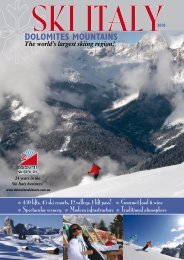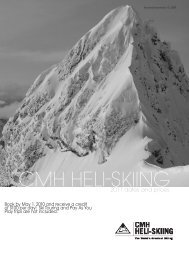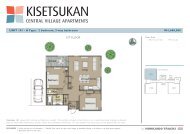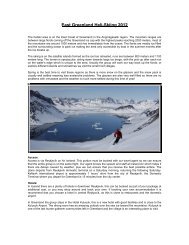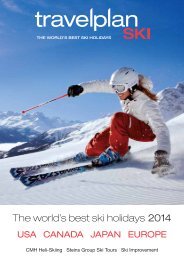Fibre-reinforced Composite Resin Bridges
Fibre-reinforced Composite Resin Bridges
Fibre-reinforced Composite Resin Bridges
Create successful ePaper yourself
Turn your PDF publications into a flip-book with our unique Google optimized e-Paper software.
GC Corporation and Professor Ian Meyers present<br />
A two day hands on training course at the world class training facilities at GC Corporation, Tokyo.<br />
Managing the worn dentition, and <strong>Fibre</strong>-<strong>reinforced</strong> <strong>Composite</strong> <strong>Resin</strong> <strong>Bridges</strong><br />
9 th and 10 th January 2013; 8.45am till 4.30pm<br />
Course attendance limited to 20 people<br />
Day ONE<br />
<strong>Fibre</strong>-<strong>reinforced</strong> <strong>Composite</strong> <strong>Resin</strong> <strong>Bridges</strong><br />
Course outline<br />
In recent years fibre-<strong>reinforced</strong> resin composites have gained increasing acceptance in clinical and laboratory<br />
applications. The combination of good aesthetics and high fracture toughness, as well as enabling minimally<br />
invasive treatment to be undertaken, provides the clinician with many alternative treatment options for<br />
patients. The most significant advantages for patients relate to cost effectiveness, conservation of tooth tissue<br />
and reduced treatment time in comparison with other complex restorative procedures. <strong>Fibre</strong>-<strong>reinforced</strong><br />
bridges can be very successful in replacing both missing anterior and posterior teeth, either as a short term<br />
solution or for longer term aesthetics and function. Their short term use over healing implant sites provides a<br />
more comfortable and acceptable alternative to a partial denture in many cases, and they can be placed and<br />
replaced with minimal chair time. <strong>Bridges</strong> can be constructed directly, fabricated chair-side or pre-made in the<br />
laboratory providing great flexibility in techniques available.<br />
This course will provide clinical information and a ‘hands-on’ experience with various fibre <strong>reinforced</strong> materials<br />
combined with a range of aesthetic and high strength composite resins. Techniques for creating aesthetic<br />
anterior and fully functional posterior fibre <strong>reinforced</strong> bridges will be discussed and demonstrated.<br />
Participants will be able to experience using the various fibre <strong>reinforced</strong> materials and undertake construction<br />
of direct and semi-direct bridges. Materials handling and clinical hints and tips will be highlighted to assist in<br />
ensuring successful patient outcomes.<br />
Course topics<br />
• <strong>Fibre</strong> <strong>reinforced</strong> composites – material types and indications for use<br />
• Case selection, treatment options and clinical techniques<br />
• Using aesthetic composites and layering with anterior fibre <strong>reinforced</strong> bridges<br />
• Creating high strength, aesthetic and functional posterior fibre <strong>reinforced</strong> composite resin bridges<br />
• Hands-on construction techniques<br />
• Longevity and maintenance of restorations<br />
Course objectives<br />
• Understanding advantages and disadvantages of different resin reinforcing materials<br />
• Develop skills in handling reinforcing fibres with different composite resin materials<br />
• Undertake construction of anterior and posterior resin <strong>reinforced</strong> composite resin bridges<br />
• Learn direct, semi-direct and indirect techniques for restoration<br />
• Aesthetic layering for maximum aesthetics
Day TWO<br />
Managing the Worn Dentition<br />
What strategies are required as patients and their restored dentitions age?<br />
Restoration of an extensively worn or badly broken down dentition can be complex, costly and time<br />
consuming to implement. Because of its complexity and cost, this treatment is often delayed until it becomes<br />
essential.<br />
Dentists (and patients!) want to stop the repeat restoration cycle and its ongoing costly restorative burden. So<br />
how do we treat the patient with a severely broken down dentition?<br />
Through lectures, clinical demonstrations and participation exercises, Professor Meyers will present four steps<br />
to restorative success:<br />
Clinical evaluation of patients<br />
• Review of a number of patient cases<br />
• Risk assessment tools<br />
• Impact of patient’s health and lifestyle<br />
• Correct treatment planning prior to restoration<br />
Oral environment<br />
• How dry mouth and salivary acidity correlates with severe tooth wear and non-carious tooth surface<br />
loss<br />
• Examination requirements, salivary analysis and remineralisation strategies<br />
• Stabilisation of the oral environment and risk reduction prior to restoration<br />
New materials and techniques<br />
• How to evaluate the range of materials and techniques available for cost-effective and conservative<br />
management; and aesthetics<br />
• Step by step procedures (using a range of materials) to allow participants to compare the various<br />
materials and techniques for direct and semi-direct restorations<br />
Practical experience<br />
• Demonstration and participant simulation exercises covering techniques for the restoration of the<br />
worn dentition; including direct restorative techniques, laboratory procedures, direct, semi-direct and<br />
indirect adhesive technologies<br />
About the presenter:<br />
Professor Ian Meyers<br />
BDSc, FICD, FADI, FPFA, FRACDS<br />
Ian Meyers is currently in general dental practice in Brisbane, Australia and has honorary professorial positions<br />
with The University of Queensland School of Dentistry, and James Cook University School of Medicine and<br />
Dentistry. He is also currently the President of the Queensland Branch of the Australian Dental Association.<br />
Following his graduation from The University of Queensland in 1982 he spent a number of years in private<br />
practice and government dental clinics. Ian then commenced working for The University of Queensland in<br />
1988 and was the inaugural Colgate Chair of General Dental Practice from 2001 – 2009, and Chief Dental<br />
Officer for Queensland Health from 2009 – 2010. He has been involved in a wide variety of research projects in<br />
the applied dental biomaterials area and has run many postgraduate and continuing education courses on<br />
diagnosis and conservative management of tooth wear. He is a product consultant to a range of dental<br />
companies and is chairman of the ADA Dental Instruments, Materials and Equipment Committee. He is a<br />
member of the International Association for Dental Research, Chairman of the Australian Dental Research<br />
Foundation Research Advisory Committee and on the Board of Directors for the Australian Dental Research<br />
Foundation. In addition he is a member of the editorial board of The Australian Dental Journal and several<br />
other international journals. His major interests include adhesive restorative dental materials, diagnosis and<br />
management of the worn dentition and teaching and clinical development in general practice dentistry.
Course Fee:<br />
$1,540<br />
Includes:<br />
All materials and course notes<br />
Welcome cocktails. 6.30pm – 8.00pm. Tuesday 8 th January 2013<br />
Course participants’ dinner. 7.00pm. Wednesday 9 th January 2013<br />
For Partners:<br />
A variety of day tours are available from Tokyo Dome Hotel<br />
Welcome cocktails evening is complimentary for partners and family (no additional cost)<br />
Partners and family are welcome to join the Course participants’ dinner. Partners & family will need to prebook<br />
with an additional cost $60.00 per person<br />
REGISTRATION FORM<br />
Please complete the registration form and return by email to: amartin@travelplan.com.au<br />
Surname : . . . . . . . . . . . . . . . . . . . . . . . . . . . . . . . . . . . . . . . . . . . . . . . . . . . . . . . . . . . . . . . . . . . . . . . . . . . . .<br />
First name : . . . . . . . . . . . . . . . . . . . . . . . . . . . . . . . . . . . . . . . . . . . . . . . . . . . . . . . . . . . . . . . . . . . . . . . . . . .<br />
Title : . . . . . . . . . . . . . . . . . . . . . Preferred name (for name badge ) : . . . . . . . . . . . . . . . . . . . . . . . . . . . . .<br />
Postal address : . . . . . . . . . . . . . . . . . . . . . . . . . . . . . . . . . . . . . . . . . . . . . . . . . . . . . . . . . . . . . . . . . . . . . . . .<br />
. . . . . . . . . . . . . . . . . . . . . . . . . . . . . . . . . . . . . . . . . .. . . . . . . . . . . . . . . . . . . . . . . . . . . . . . . . . . . . . . . . . . . .<br />
Telephone : . . . . . . . . . . . . . . . . . . . . . . . . . . . . . . . . . . . . . . . . . . . . . . . . . . . .<br />
Email : . . . . . . . . . . . . . . . . . . . . . . . . . . . . . . . . . . . . . . . . . . . . . . . . . . . . . . . .<br />
Please highlight or tick:<br />
I wish to register for Managing the worn dentition, and <strong>Fibre</strong>-<strong>reinforced</strong> <strong>Composite</strong> <strong>Resin</strong> <strong>Bridges</strong> on<br />
9th and 10th January 2013<br />
I would like to attend the Welcome Cocktail Event on 8 th January 2013<br />
I would like to attend the Course participant’s dinner on 9 th January 2013, and I require<br />
(number) additional tickets for the Course participant’s dinner at AU$60 each<br />
I would like to visit GC Research & Development Centre on Friday am 11 th January 2013




